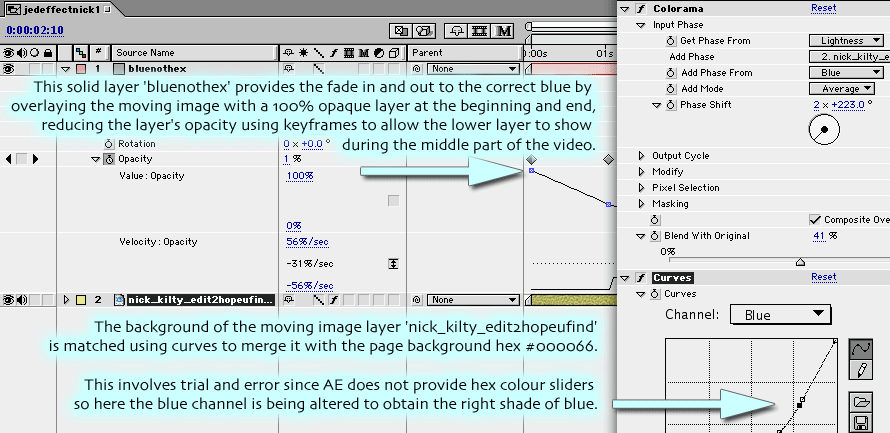
MAiP Practice 1 EVALUATION - J.E.D. Gibbs
Using After Effects to prepare online video.
Practice 1 excerpt from my learning contract:
"The dv-video needs to be edited, composited where possible to show multiple angles, and colour retouched and manipulated to fit with the style of the new site.
This will need skills in Final Cut Pro and After Effects which I do not yet have."
For Final Cut Pro, substitute iMovie and Premiere
One reason for taking Digital Video for Practice 1 is to bring my skills to the point where I will be able to teach on a new Media course at Southampton City College in September 2004. A decision has now been made there in favour of Adobe Premiere rather than Apple's Final Cut Pro, partly for Premiere's cross platform availability for Macintosh and Windows, partly because there are some members of staff with Premiere experience. Southampton TV use Premiere, personally I prefer Final Cut Pro.
Southampton City College students will get their first taste of video editing in Apple's free iMovie. I really like capturing and rough cutting video in iMovie, despite its single video track. Although basic, it often gets the job done very quickly without adding the sophisticated features which clutter Premiere and make it hard to achieve much until you have reached a critical mass of knowledge.
My opinion of Premiere is clouded by my experience of trying to learn version 5 with the 'help' of the QuickStart Guide. This is a poor example of an otherwise good range, it seems to redirect you to another chapter every few lines and left me fuming.
After Effects
One advantage Premiere has is its close integration with Adobe After Effects, which Julian was good enough to demonstrate to me during an extremely helpful one-on-one session in After Effects. This helped me turn the corner from total frustration to a point where I can now use the programme for the main features that I wanted. I greatly under-estimated how long it would take me to learn After Effects, which I had no experience of prior to Practice 1. I did not find it at all straightforward, and like Premiere it requires a certain level of competence before even simple tasks can be achieved. By the time I had reached the point where I could process a video clip quickly, the deadline for Practice 1 had arrived, which was immensely frustrating as I want to add a lot more video clips to my live Web site, but this work will be too late to be recognised for the MA, at least for Practice 1. I may change my Major Project to incorporate more video since there is a lot more still to learn and to do. Although I feel I have little to show for my time, I am proud to have gained my confidence with After Effects at last, it is a really key piece of software.
The Workflow
1. Logging the tapes
I have shot over thirty hours of DV tape and have many more VHS and sVHS tapes to plough through. In an effort to get organised, here are two examples of the logging sheets I devised:
Nick Harper Southampton Automatics
2. Capturing the video
I tend to use iMovie, it is just so easy.
3. Dragging raw DV footage into After Effects
iMovie creates a folder full of raw DV clips which can be dragged into After Effects.
4. Making a masking layer to integrate the video into the web page background
I like the effect of the video as it emerges and later sinks back into the page background, rather than waiting as a paused rectangle. This is the equivalent of a fade to black, except that any colour background can be matched. It was important to create a look that would be in character for Nick Harper's new Web site Harperspace.com as my site may be linked from a button on the main site, and it needs to maintain consistency. Although far from finished and advertised only inadvertently through Google's spidering of my site, the main Nick Harper fan site lists my video page third, after only Harperspace and Nick's record company site Quixotic. Here is what they currently say about my video page:
http://www.jednet.co.uk/nick/index.html
The HHOH isn't the only Nick site with video clips of the man in action. Looks like some test work that may have been done before Nick's Surround Sound shows in summer 2001 made it to the web too. In "secret". Though I've seen links to this site in various places! The clips themselves are pretty damn cool... and you can see the "Harperspace Wars" video that gave us all a good laugh at those Surround Sound shows here.

5. Recolouring using Colorama, Curves or Hue and Saturation
Most of my video clips have been recorded in pubs and small venues where I have no control over the lighting. It is not uncommon for a landlord to turn off the lights as a band comes on. As a result the tape often has appalling colour balance and little contrast. It can sometimes be better to stylise the look rather than attempt an impossible retouch back to a 'natural' look. With such poor lighting, watching some men in a pub can be less than inspiring.
I enjoyed creating the look for the Southampton Automatics. Unfortunately I initially did this in Photoshop, using a Gradiant Map. It was a difficult look to recreate in After Effects using the Colorama filter instead. Once I had managed it, I could have just taken a frame grab to make the main background image, and so not needed to use Photoshop at all.
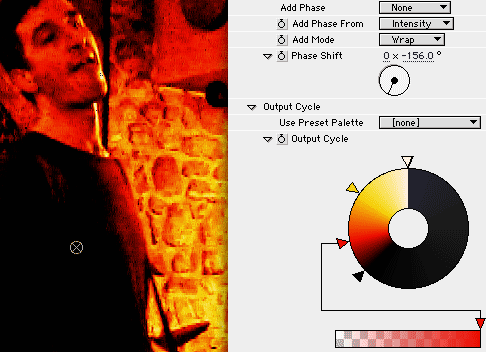
6. Other corrections as required
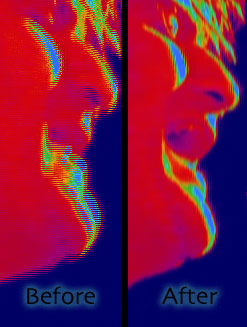 A.
A. 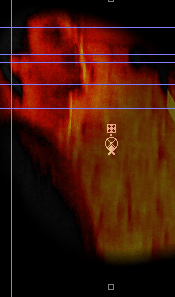 B.
B.
A. using the de-interlace filter in After Effects.
Julian did explain about a preference file governing how AE deals with interlacing issues, but I confess it did not get retained by me and I had to resort to this filter, which was better than leaving it as it was. The otherwise excellent 'Creating Motion Graphics with After Effects' Volume 1 2nd Edition by Trish and Chris Meyer (CMP Books) simply referred me to Volume 2, which I do not have.
B. The Automatics 'Britney Spears' video included a moment when the camera was knocked. This I corrected by moving the image frame by frame behind my mask across about eight frames. This made the incident far less apparent.
7. Adding masks around the subjects to remove the rectangular look
Part of my drive to get rid of rectangles and to make the video more a part of its surroundings. The mask for the Automatics video 'Britney Spears' changes shape, has a soft feathered edge, and eventually is actually a combination of four masks to achieve a cartoon-like 'iris out' on the singer and lead guitar player. My first attempt at a feathered mask was very frustrating since I attached it to a layer which had a colorama filter applied. The filter had the effect of posterising the shades on the layer into discrete bands, which prevented me from achieving a feathered look and gave my mask a hard edged appearance. It was a long time until this explanation dawned on me. I solved the problem by inverting the mask to create a hole in a new black layer which could be feathered.
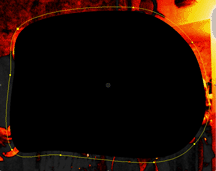
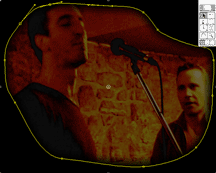
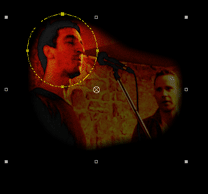
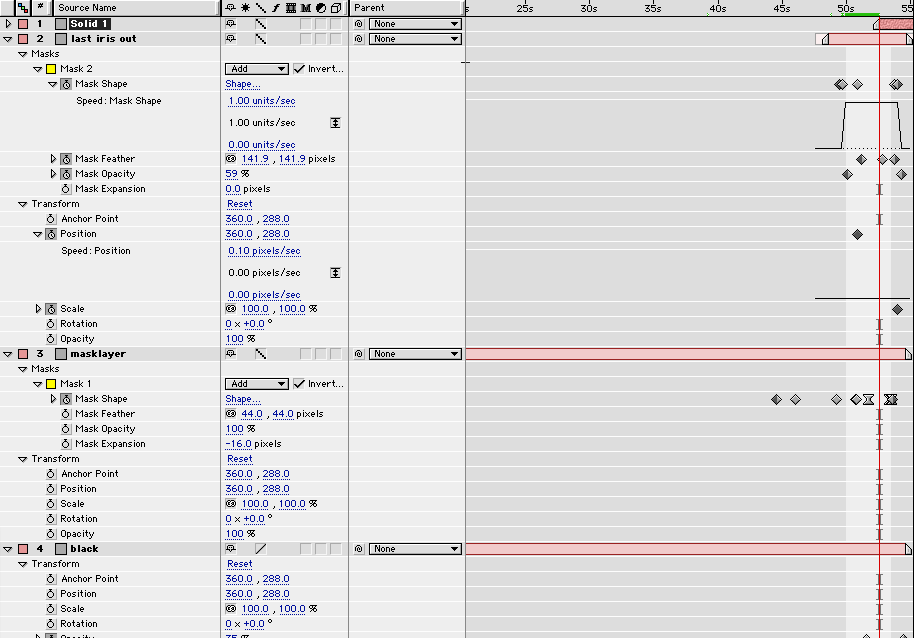
8. Rendering the video to a suitable size and frame rate trying to balance quality and file size.
Hours of trial renders led me to the following settings:
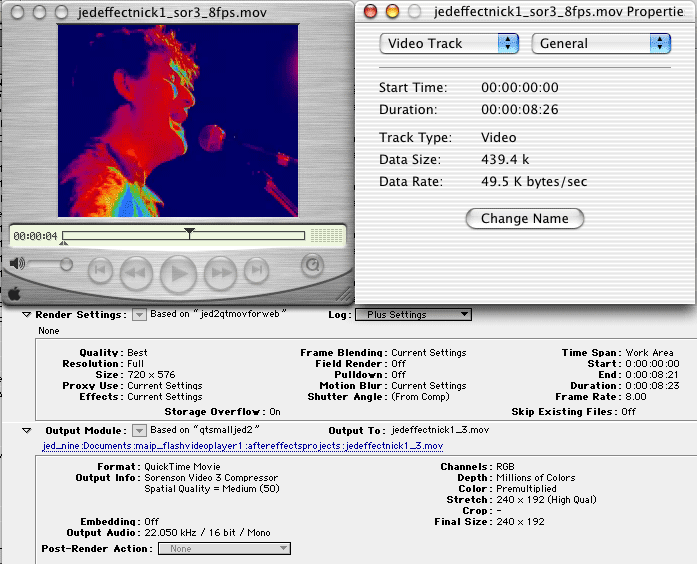
Settings for Nick Harper 'festival' version of Kilty Stone
Belatedly I bought 'Creating Web Video with Adobe Premiere' by Thomas Luehrsen (Peachpit).
It has helped me with understanding keyframe rates, and given me more confidence in my ears and eyes as the values he recommends for several key decisions are those that I reached through trial and error - the book could have saved me a lot of time but I have gained a deeper understanding by experimentation of my own.
His recommended audio settings for 56k modem exactly match my most used settings: (p147)
audio rate cut from 44,100 to 22, 050 - halves the data rate and filesize.
format 16bit mono - halves the data rate and filesize again. My audio has mostly been captured by the camera's built-in microphones and has no appreciable separation or differentiation between the two channels anyway. Furthermore since many PCs have a single internal speaker, sending twice as much audio data than such hardware can handle is not efficient.
compressor QDesign Music 2 'real mainstay of Web audio in the QuickTime format' reducing audio to as little as one percent of the size it was as an AIFF or WAV. Qualcomm PureVoice is recommended as a possible alternative for a soundtrack containing speech.
What I did not know was to choose 10 kbits per second as a datarate, which adjusts the amount of compression applied to Luehrsen's quality vs filesize solution. Other settings include interleave: 1 second and Enhance Rate Conversion set to best - which provides better audio at the minor expense of just taking moments longer to encode.
8. Incorporating the video into a Flash player or adding it in QuickTime format as a link or embedded file
The Flash player started life as a magazine project in the Complete Flash MX Handbook from Future Publishing.
There were similar players in other magazines including .net magazine June 2003. I also read and re-read Flash MX Upgrade Essentials. In many ways I wish I had just started from scratch as the programmer from the Complete Flash MX Handbook has a very different approach to me - I like to see timelines and scenes, while the programmer likes to encapsulate parts into movie clips, which makes dissecting them and customising difficult for a comparative Flash newcomer such as myself. Nevertheless I managed to change the look of many of the elements and turned the linear volume control so that it was vertical like a mixer/fader. I researched the look of mixers to the point that I ran out of time to actually make any changes! I have not even added a graphic or 'vol' but most people seem to guess at the slider's purpose. I am very pleased with the music staff metaphor for a progress bar, which I think conveys the passage of time well. I drew up some guitar chords, but decided against them except for the specialised role of guitar tuition.
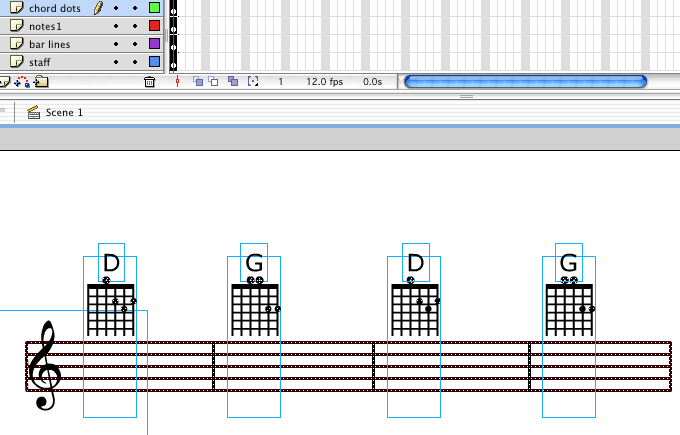
The quality of the Sorenson Flash encoder is either poor for the resulting filesize or I am missing something profound. In testing there were spikes of heavy download so I added a sort of preloader, the test 'Kilty Stone' introduction is so small that it allows a lot of video to be downloaded while it is playing, which reduces stutter later.
9. Uploading the video to a server.
I have a choice of server space - 15mb free from tcp.co.uk or my Apple iDisk which is a subscription service providing 100mb. I set up the same file on each, with a different name to prevent caching, to test the server speed:
In practice, both were too fast to tell apart on a modem, restricted by the modem's limit of about 4k/second rather than their own server limit.
Close this window